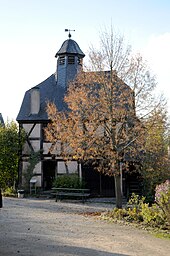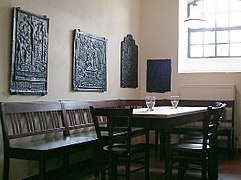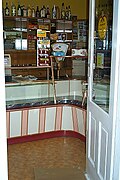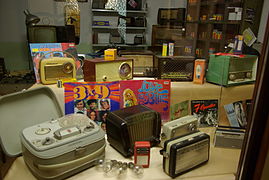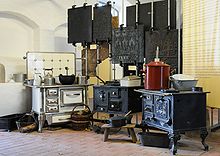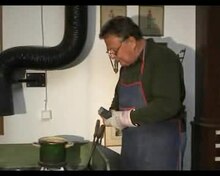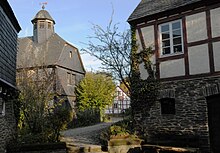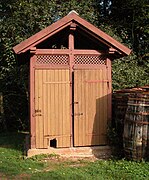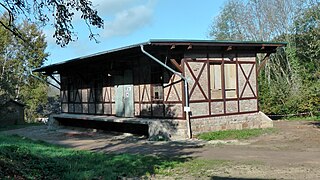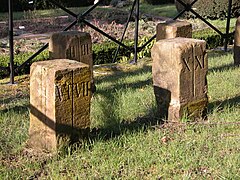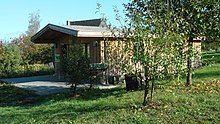Folklore and open-air museum Roscheider Hof
 The main building of the Hofgut |
|
| Data | |
|---|---|
| place | Conc |
| Art |
Folklore museum, open-air museum
|
| opening | 1976 |
| Number of visitors (annually) | 70,000 |
| management | |
| Website | |
| ISIL | DE-MUS-275818 |
The folklore and open-air museum Roscheider Hof is an open-air museum founded in 1976 in Konz ( Trier-Saarburg district , Rhineland-Palatinate ). The museum is located on a hill above the Moselle valley in the Konz-Roscheid district on the border with Trier . Its task is to present the folk culture of the region around the Moselle and Saar , which includes the Eifel , Hunsrück and Saarland as well as parts of Luxembourg and Lorraine . With 4,000 square meters of exhibition space and 22 hectares of open space, it is one of the largest German folklore museums. The exhibitions A small world in pewter , toys from all over the world and Takenplatten are of supraregional importance . The museum is supported by the Folklore and Open Air Museum Roscheider Hof, Konz e. V. with over a thousand members. Location: 49 ° 42 ′ 17 ″ N , 6 ° 35 ′ 50 ″ E
history
The first mention of the main building of the Roscheider Hof is in a document from the Benedictine Abbey of St. Matthias in Trier . In 1330 the abbey sold a pension and pledged its Roscheid farm as security. A second mention followed 21 years later. In the oldest surviving lease document, the convent awarded the Roscheid farm with fields, meadows, forests and all accessories to Johann von Konz and his wife Else for 18 years. The names of all subsequent tenants have been handed down to the last lease from 1793. The courtyard consisted of two opposite buildings. The building on the north-eastern side with the living area, cattle and horse stables has been preserved in the existing part of the four-sided courtyard . During renovation work in 1978, some finds came to light that suggest a date to the early 16th century and earlier.
In 1794, when French revolutionary troops marched in, the feudal age also came to an end in Kurtrier . The Roscheider Hof was sold to the French state as an expropriated monastery property in 1802 and bought by Nikolaus Valdenaire from Saarburg on March 7, 1805 for 8500 francs . Valdenaire, a French soldier, had married into a local family. He was an influential figure with ideas influenced by the French Revolution . He expanded the estate, which had only changed little for three centuries, and built the four-sided courtyard in its present form, which is unusual for the Trier region. The outbuildings of the outer courtyard were built later.
After Valdenaire's death in 1849, his son Viktor Valdenaire, who was a friend of Karl Marx , showed little interest in the court. However, the farm was only sold in 1864. Later, with government support, an agriculture school was established in the Roscheider Hof. This was moved to Saarburg in 1871. After several changes of ownership, the farm and the associated lands were acquired by the royal Prussian treasury in 1909 and subsequently managed as a state domain . After the Second World War , this was transferred to the state of Rhineland-Palatinate . The last head of the state domain, Edgar Studt, supported the idea of the open-air museum in order to be able to relocate the operation from the outdated buildings to a rational new building. This did not happen because the city of Konz acquired the Roscheider Hof on June 9, 1969 for 2,500,000 DM from the state domain administration with the aim of building the new district of Konz-Roscheid on 150 hectares. The courtyard building was intended for an open-air museum with an area of 20 hectares.
Creation of the museum
history
After more than ten years of efforts to establish the central open-air museum for Rhineland-Palatinate in Konz had failed, the sponsoring association of the future museum was founded on June 12, 1973 in the conference hall of the Konz town hall. This also happened as a defiant reaction after the then Prime Minister Helmut Kohl had been ordered on May 15, 1971 to stop all initiatives regarding an open-air museum at the Roscheider Hof.
The museum was created on the initiative of individuals and with the support of some municipal and regional decision-makers. The driving force was Rolf Robischon , architect, building researcher and professor at the Trier Building School (today Trier University of Applied Sciences ). From 1975 onwards, collected museum items were stored in rooms of the courtyard building, which had been repaired in advance. Between 1975 and 1976 a first house was transferred, the town hall from Gödenroth . In the courtyard building, eight rooms were furnished with collection items and the museum was opened with modest furnishings on July 17, 1976 in the presence of the then Minister of Education, Bernhard Vogel .
The oldest museum rooms are behind the entrance from the courtyard of the courtyard building. A so-called mom and pop shop from the first half of the 20th century, classrooms and weaving room are still almost as they were when they were first set up. A hairdressing salon and a village pub have meanwhile moved to Ladengasse and the old kitchen to the Saargauhaus . Today the Children's Worlds exhibition is located in this area .
Rolf Robischon was the museum director in the first development phase until 1985. For his services, which he earned until his death in 1989, he was granted honorary citizenship by the city of Konz .
Ulrich Haas was the honorary director of the museum from 1985 until his death in December 2015. Before that, he was head of an industrial company until his retirement. He devoted himself increasingly to the completion of the Hunsrückweiler , the Moseldorf and, above all, the expansion of the courtyard building into an exhibition building. However, this was leased to a farm until the end of the 1980s, which delayed expansion. In November 2008, the last part of the courtyard building, a large barn, was taken over by the museum. In 1996 the museum area was fenced in to prevent further damage from playing children and wild boars .
Corner shop in the exhibition building, the oldest part of the museum
In the following years, additional rooms for thematic exhibitions were opened up. In the Hunsrückweiler a bakery and a school as well as the first houses of the Mosel construction group were built. During this time, two alleyways and the tin figure exhibition were set up in the exhibition building, as well as several toy collections. An exhibition on life in the forest was set up in a modern exhibition building, and an exhibition on the Konz railway junction was set up in a former goods shed.
On June 11, 2006 the city council decided unanimously to grant Ulrich Haas honorary citizenship of the city of Konz for his work as museum director .
In March 2016, Helge Klaus Rieder was elected first chairman of the association by the general assembly of the museum association.
Concept and structure
In 2008 the museum consists of a four-sided courtyard that is used as an exhibition building and restaurant. Other parts of the museum are a Hunsrück village with eleven buildings, a Moselle village under construction, a forest and wood museum in a modern exhibition building, a border stone museum , several gardens, two chapels, orchards , arable land, a children's playground and an oil mill , which is about two kilometers away remote branch.
The basic idea is to depict the different living environments in rural areas, which range from day laborers to farmers and winemakers to more village-like professions such as craftsmen, dentists and pharmacists. The same applies to the living conditions. The time core covers the period from 1860 to 1960, even if some of the exhibits are significantly older. So two opposite half-timbered houses in the style of 1870 and 1950 were set up. Three different mom and pop shops show the development in retail over a comparable period of time. A special feature for open-air museums is the children's world, in which three toy collections and an exhibition of pewter figures are integrated. The museum publishes monographs in its series of publications and the Roscheider Blätter for its members at the end of the year .
The limited financial resources made it impossible to follow a defined development plan. Rather, favorable opportunities had to be used to acquire buildings and museum goods. Numerous exhibits came into the house as donations, some showcases were contributed by other museums. Due to a lack of space, however, not all items offered to the museum could be accepted, and for financial reasons not all buildings offered to the museum could be transferred to the museum. With the exception of chickens, animal husbandry has also been avoided up to now.
Folklore exhibitions
The main exhibition building is the Vierseithof, in which various folklore topics are presented on more than 3500 m² . A thematic exhibition on the subject of forests and forest management is located in the forest museum in the lower area of the outdoor area. Individual craft workshops can be found in the houses of the Hunsrückweiler and Moseldorf villages.
From grain to bread
While some areas benefited from technical advances that had been made in Belgium since the 18th century, in parts of the Eifel and Hunsrück it was increasingly difficult to remain competitive until the 19th century because productivity could not be increased. This was especially true for the courtyards of the barren low mountain range, less so for the climatically favored valley locations.
The focus of the collection is the mechanization of agriculture from around 1930. To create a contrast, plowing and sowing by hand, mowing with a scythe and threshing with a flail are first discussed and illustrated by exhibits, such as a simple wooden plow.
The first wave of mechanization included manually operated pin threshers and wind sweeps . However, steam engines and locomobiles are not part of the museum's collection, since such complex machines were not profitable in the low-yielding low mountain range. The mechanization and motorization is represented by threshing machines , mills, flour silos and one of the first combine harvesters . The museum also has a number of tractors , some of which are still in use on the museum fields. Working with these devices is demonstrated on Farmers' and Craftsmen's Day in September. It was thus possible to develop a coherent concept, although the late founding of the museum only rarely allowed the acquisition of pre-industrial exhibits.
At the end of the exhibition is the bakery of the former Gail bakery from Polch im Maifeld in a separate room, which was rebuilt as it was in the 1930s.
Wine, viez, schnapps
The exhibition shows the work steps necessary for viticulture, which began in Roman times, from planting the vines to bottling. In addition to wine, sparkling wine , viez and fruit brandies also have a long tradition.
In addition to Riesling and Elbling , the exhibition's “vineyard” also contains Müller-Thurgau vines, which are also called Rivaner in Luxembourg. The exhibition continues in the cultivation techniques, in which the use of pesticides is also discussed. Pictures and a diorama of the grape harvest in the early 20th century lead to different types of presses.
While the tree presses work on the principle of leverage, spindle presses work with spindle pressure. They take up much less space. The oldest wine press in the exhibition, the wooden spindle press, comes from Traben-Trarbach and was dated to 1641 with the help of dendrochronology . However, the wooden spindles were often not able to withstand the high loads. The triumphant advance of the spindle press began when iron spindle presses became available as a result of the industrial revolution.
A wine press made by André Duchscher & Co. from Wecker in the Grand Duchy was widely used in the Trier region and in Luxembourg. It works with five or seven drop wedges and is also known as the Weckerkelter or, because of the sound of the falling wedges, also called the Klippelter. Presses with drop wedges have the advantage of requiring less space, as the winemaker does not have to go around the whole press when turning the lever arm. The functionality of this wine press is demonstrated at the annual press day in October. The company's last model stands for the end of a development: the high-pressure press pressed the grapes so hard that the wine made with it no longer tasted good.
After pressing, the must was fermented in barrels. On the Saar and Moselle, the barrel drums (960 liters) and half barrel (480 liters) shown in the exhibition were in use. The wine-growing exhibition concludes with traditional wine bottles, wine labels and filling systems for the Mosel-Saar-Ruwer growing region .
In less favorable climatic locations, apple trees were planted instead of vines. These apples were pressed to Viez . The juice was typically drunk from a porcelain vessel called Porz . Viez was the drink of the less well-off people. Even vintners only enjoyed wine on holidays. This becomes clear in the exhibition in the reproduction of a painting by Beilstein: In a pub garden, the “better gentlemen” enjoy wine from glasses, at the next table farmers and vintners drink Viez from Porzen.
A wide range of apples, pears, plums, mirabelle plums and other types of fruit provide the basis for the production of fruit brandies . The exhibition shows a large number of stills as well as graphs of the development of alcohol consumption per capita and provides information about customs such as servant recruitment. This usually involves signing new employment contracts for servants on a fixed day in winter or extending employment contracts, usually for a further year. There are also courtship and wake, in which the jug of schnapps had its permanent place.
A symbolic illicit distillery is also shown. The complete establishment of a schnapps distillery from Cochem with distillery , sales and office space, which was abandoned in 2002 , is in the Saargauhaus in the open-air area. It was completely rebuilt in 2005.
Bourgeois home decor
The exhibition area shows the living culture of the bourgeois upper class from the Biedermeier period to the post-war period.
The representative Biedermeier room has translucent curtains over the large windows. The furniture is restrained with ornaments provided and more focused on the impact of their expressive wood grain. In the early Biedermeier period, light woods such as pear, birch or cherry were preferred. In the 1950s and 1960s, with the French influence, darker types of wood such as walnut and mahogany were added. Other furnishings include a writing desk, cast iron stoves and a square piano . A bedroom and another room in which a coffee table is set around 1840 belong to the same era. For comparison, a neo-Biedermeier coffee table from around 1910 can be seen in a neighboring room .
The further development of bourgeois living culture is shown in three living rooms with furniture from the Wilhelminian era around 1890, in the Art Déco style around 1920 and from the 1950s in the domestic style of the 1930s.
School and church
The exhibition shows a classroom with equipment typical of the imperial era: wooden benches, slates with tabs knotted on them, a slightly elevated teacher's desk with slate, calculator , cane and stove. On the walls School murals .
In the room next to the classroom, visitors are informed on information boards about everyday school life from the introduction of public schools to the end of the imperial era: the schools in the country were mostly only one-class. The guideline number for the class size was 60 students - in reality, however, there were up to 100 children from first to eighth grade in one room. Visitations brought at best a temporary improvement in conditions.
The topic of popular piety is of great importance in the predominantly Catholic area around Trier. Birth and baptism, First Holy Communion , marriage as well as death and burial were the turning points in life that were ritually committed. These stations are shown in the form of a tour. The wedding with a bride and groom in the black wedding clothes customary around 1900 is particularly emphasized. Another topic is brotherhoods in general and the Sacred Heart Brotherhood in particular. A showcase overflowing with different Sacred Heart figures underscores their importance.
Craft and trade
The presentation of handicrafts and trades is concentrated in the shop alley opened in 2002 . There are a total of twelve shops and small commercial shops which, in their lane-like arrangement, allow glimpses through windows and doors. In the course of the 20th century, craft businesses such as crank stickers, shoemakers , upholsterers , cutlers and grinders were less and less able to survive. The pewter , tailor , hat maker and plastering trades are also carried out in factories today. Other trades such as butchers and grocery stores, watchmakers and photographers found their way into the exhibition, as well as dentists and pharmacies. The development of rural retail trade is shown in three corner shops (around 1890, around 1940 and in the 1960s).
At the end of the exhibition area there is a village inn from the 1930s, which has also served as a backdrop for film productions. Other craft workshops can be found in the houses on the open-air site. A painter's workshop in the Oberemmel house, a weaving mill in the Schuche house, another shoemaker's workshop in the Bosselstube, and a cooper and wheelwright (Wagner) in the forest museum.
Some of the shops and workshops (pewter foundry, cutlery, painter's workshop, upholstery, hairdresser, pharmacy, dentist, butcher, 1960s grocery store) could be taken over by the last owners or their heirs and were rebuilt with only slight additions in the museum. The other trades were put together from the museum's holdings.
Based on the donation of a complete metal goods store and the public success of the first alley, a second alley was opened in the south wing of the exhibition building at the beginning of the 2013 season. A metal goods store, a plumber , a hat shop , a savings bank branch , a country doctor's practice , an architect's office , a radio and television shop , clothing stores for women's and men's fashion, a factory for lampshades and lamp making and a bookbinder's workshop are on display . The time section of the second Ladengasse is around 1960. In the spring of 2015, the last shop for men's hats, the Georg hat shop in Trier with its completely preserved furnishings from something before 1900, was taken over into the museum.
Opening of the second shopping street
Taken plates and stove plates
Taken plates are cast iron plates that used to be built into a recess in the fire wall between the kitchen and living room in farmhouses. If they were heated by fire and smoke on the kitchen side, they also gave off heat to the living room via radiation and convection of the air. Taken plates were manufactured in ironworks in Eastern Belgium, Lorraine, Luxembourg, the Eifel, Hunsrück and today's Saarland. The oldest known plates date from the late 15th century - a time from which almost nothing has been preserved from the rural culture in this region.
Oven panels are similar in shape and manufacture to Taken panels, but the side panels have tabs on the edges that allow the panels, which have been assembled to form a five-panel oven, to be walled into the wall with their backs.
Plates from various foundries are shown in the exhibition. The focus is on the hut in Quint , which has now disappeared (today a district of Trier ) and the hut in Weilerbach, which is still in ruins (today a district of Bollendorf an der Sauer ). The exhibition explains the iconography of the plates for Catholic, Protestant and Jewish households using many examples and explains how they are made. More Taken plates hang in the museum restaurant, which also has a reconstructed Taken heater.
Cultural history of washing
Quite unique in the German museum landscape is the presentation of the history of washing from the washing area by the stream to washing machines and mangles . While the beeching , i.e. washing with wood ash, rinsing in flowing water and bleaching in the meadow was still common in the farmhouse , there was only the laundry room and the clothesline in the courtyard in the urban or middle-class environment. The basic technology of washing machines is illustrated using a Miele washing machine from 1913. Washing by hand and with historical washing machines is shown annually on Farmers and Craftsmen's Day in September.
Children's worlds
As the first toy exhibition in 2004, the exhibition “Children's Worlds” was inaugurated. The “boys department” shows movable tin toys, kits and packaging from the Werner Springsholz collection, the “girls department” around a hundred dolls from the collection of Mrs. Leick from Perl .
The toy collection of Professor Barbara Schu, who works at the Cologne University of Applied Sciences , was added in 2006. The textile designer had collected over 5000 toy figures on her travels. She originally bequeathed her collection to the Rautenstrauch-Joest-Museum in Cologne in 1988 . Since this museum did not see itself in a position - as stated in the will - to exhibit the collection completely and permanently, the collection could be reopened in 2006 in the open-air museum Roscheider Hof. It is largely presented in mahogany cabinets that are also part of the collection. One focus of the collection is a collection of rare wooden toys from the Ore Mountains. Another focus is on dolls from the broad spectrum of folk art, customs and souvenirs from Latin America , Russia and Asia.
Tin Figure Museum
The tin figure exhibition is a "museum within a museum". The historian Klaus Gerteis ( University of Trier ) built a private tin figure museum in Aach near Trier according to scientific criteria . This moved to the Roscheider Hof in 2005, tripling the exhibition area. A small world in tin with many thousands of figures, not just tin soldiers, is built on the 220 square meter warehouse of the manor . The exhibition was supplemented in 2007 by a diorama of a Roman legionary camp and in 2008 by a pewter workshop.
With the exception of a few exhibits, the figures were collected, produced, painted and set up in dioramas by Klaus Gerteis in a collector's activity that spanned more than five decades. The exhibition is structured according to four aspects:
- The development of pewter figures from around 1800 is illustrated with old figures and casts made from old molds.
- The exhibition takes into account the personal focus of the collector. The packs in which the pewter figures were sold are also shown along with their contents. Another focus of the collection are old vehicles and games with pewter figures.
- In dioramas with pewter figures, themes related to the history of the region are shown.
- In a demonstration workshop, the engraving of forms, the casting and the painting of pewter figures are shown (see video).
Gemstone cutting
A gemstone cutting shop is located in the passage to the inner courtyard of the museum. The area around Idar-Oberstein in the Hunsrück is traditionally the region of the gemstone cutters. On most weekends, a cutter from Hunsrück demonstrates this work, mainly local semi-precious stones being cut.
Outdoor area
The outdoor area of the museum has a size of 22 hectares, with approximately the same amount of expansion reserves available. The site comprises two sub-assemblies, the museum fields, the orchards, various gardens, technical monuments and beehives.
Hunsrückweiler
The Hunsrückweiler consists of ten half-timbered houses and a bakery from the Hunsrück. As early as 1974, the village town hall of Gödenroth was the first new building to be transferred to the museum. The expansion of the Hunsrückweiler was provisionally completed in 2008 with the interior construction of the school from Würrich . Houses of particular interest are:
- The village town hall from Gödenroth was the first building that was erected in the open-air museum. It is exemplary for the town halls in the Protestant communities of the Hunsrück. Catholic parishes were subordinate to the Kurstaat Trier and no parish self-administration was tolerated by this. The ground floor was temporarily used as a poor house for the community. The coach house next door was initially used as a stable for small animals and later to accommodate fire extinguishers.
- The schoolhouse from Würrich is the oldest building that has been moved into the museum. The timber of the framework was felled and built in the spring of 1680. The house was initially one-story and served as a school and teacher's apartment from the start. Since there are no pictures or exact descriptions of the appearance of classrooms in the late 17th century, it was not possible to reconstruct a classroom from this period. In the basement there is an exhibition on the subject of schools and on the upper floor there is an exhibition on the subject of “Preservation of Food”. The school house was dismantled at the original location in 1996. The topping-out ceremony was held in May 2000. The house was then used to demonstrate the half-timbered construction and for corresponding school class projects. The work on the upper floors that was dangerous for school classes was carried out in 2007 by museum employees and specialist companies; the house was furnished and opened to the public in 2008.
- Since the museum was founded, there has been a desire to build a bakery in the Hunsrück village. A suitable property could only be found after years of searching. It is a small, one-story slate stone building. The interior consists of a space, the rear third of which is taken up by the oven . It originally belonged to five baking companions who built it themselves in 1932. During the dismantling it turned out that not only furnace stones were used for the masonry, but also broken sandstone troughs and other waste rock.
- The Schug House or Schuche House , as it was called, is a half-timbered house with a two-room-deep floor plan. Such residential buildings have been characteristic of the eastern Hunsrück since the 18th century. The interior is set up as the house of a sideline weaver .
- The Trappitschen house is a two-room-deep building typical of the Vorderen Hunsrück, dating from around 1830. During a major renovation in 1915, the originally existing crooked hips were removed so that the building received its current characteristic appearance, which is determined by the gable roof. In the museum, the building was furnished as it was in the early 1950s, a time in which the economic miracle was at best indicated. The furniture then also shows a strange mixture of older pieces of furniture, which came from before the war, and typical 1950s furniture.
- The Molz house is the house of a farmer from Fronhofen near Kleinich who is wealthy by Hunsrück standards. Due to the early death of its builder, it has only been inhabited sporadically in times of need since 1875 and has been preserved without any major modifications. During World War II, the house was a branch of a prisoner-of-war camp , mainly for French prisoners of war . A thematic exhibition is located in the hall of the house. On the upper floor, the grating of the windows and the furnishing of the bedroom with beds made of raw wood for the prisoners of war were reconstructed according to old photographs.
- The neighboring house Klaesjes is much more simply built and furnished. It was a swineherd's house, later that of a tailor.
- The lowest level in the social hierarchy of a village included the residents of the Franz house , which is set up as a forge in the museum. The building was originally a day laborer's house on the outskirts of Irmenach . His daughter had three illegitimate daughters. Their daughter, who was born in 1800, had an illegitimate daughter. She too had a daughter - barely twenty years old - without being married. They lived on small services for the villagers, were messenger women, sold butter at the market in Traben-Trarbach and possibly also worked as prostitutes . It was not until 1928, after the death of its last owner, that the house was converted into a forge.
The gardens in the Hunsrückweiler represent cottage gardens around 1900 in a low mountain range.
Moselle – Saar
The houses of the building group Mosel - Saar are all stone buildings. Compared to the half-timbered houses from the Hunsrück, these can only be transferred to an open-air museum with significantly more effort and higher costs. Buildings of this assembly are:
- The Saargauhaus. This building is a replica of a type of house typical of the Trier region, which is why it is commonly known as the “Trier Einhaus”. It is the variant of a house type that occurs in the whole of south-west Germany ("broadly structured Quereinhaus"). The building was built on the model of a large farm in Köllig on the Saargau. It was measured in detail in 1987 and subsequently rebuilt on the museum grounds. In addition to fragments from demolished houses, modern building materials were also used. After completion of the shell, construction progress almost came to a standstill for over ten years. In the basement there is a kitchen and a living room (opened in 2006), the distillery of the company Jean Marx from Cochen, founded in 1881. After the distillery was closed in 2002 and the distillery had to be removed from its location for customs reasons, it was moved to the open-air museum in 2005. Like the one in the Sensemichel house in the Hunsrückweiler, the apartment on the upper floor is rented to a museum employee.
- On the other side of the path there is a well house which has been used for the water supply of the Roscheider Hof since at least the 19th century and which was built in its current form to supply water to several nearby Siegfried Line bunkers .
- A school toilet from Portz, district of Merzkirchen , near Saarburg . It is a small half-timbered building lined with bricks. The house had probably only survived the change in the sanitary culture because the schoolmaster later converted it into a chicken coop.
- As a technical monument, a pump house with a Lambach pump, also from Konz-Oberemmel. A Lambach pump is a reciprocating piston pump in which a large float, moved by the introduced stream water, drives a piston in a cylinder located above, which pumps spring water through a pressure pipe into an elevated tank. The pump house itself is a reconstruction, as the house should be kept at its original location.
- The Stein house from Niedermennig. The house of a craftsman (mason), with a small economy for personal use.
- A typical outbuilding from Konz-Oberemmel from 1734. It is set up on the upper floor as a painting workshop.
- A goods shed that was built next to the Konz train station at the end of the 19th century, lost its function due to the abandonment of general cargo and had to give way to a redesign of the station square in 2014.
Trees, gardens and stones
Corresponding to the exhibitions on bourgeois living culture, there is a rose garden with a historical pavilion and a herb garden below the exhibition building . There is an exhibition of historical boundary stones above the rose garden. Below the rose garden, old grave crosses were set up around a historic chapel from the Westerwald. The tomb of a Russian prisoner of war from the First World War is remarkable . More tombstones came into the museum when, between 2006 and 2007, as part of the valorisation of the Roman heritage in Konz, Roman walls were uncovered next to the Konz parish church and old tombstones had to be replaced.
The museum has orchards with regional fruit varieties and small museum fields on which various crops are grown. The gardens of the Hunsrückweiler represent gardens in the Rhenish low mountain range around 1900. The garden at Trier Einhaus represents a garden in the Saar or Moselle river valley around 1950. Both gardens were created as part of the Gardens without Borders project in 2000 and 2001 newly designed. Since 2014 there has been a training apiary on the edge of the orchards run by the Concern Beekeeping Association .
Forest and wood museum
The forest and wood museum is located in a modern exhibition building below the Hunsrückweiler. It was built in 2004 and 2005 with the support of the Trier-Saarburg District Forest Farmers Association and opened in October 2006.
The exhibition is an important pillar in the overall concept. It bears witness to the work of forest farmers, foresters , hunters and raftsmen . The forest museum also houses the office equipment of a forestry office, workshops for woodworking professions such as wheelwright , also known as Wagner in some areas, and barrel coopers, as well as a large saw frame from Saarburg .
Branch office oil mill
Location: 49 ° 41 ′ 31 ″ N , 6 ° 37 ′ 48 ″ E A branch of the museum is a historic, functional oil mill in the little concert hall . The mill in the valley of the Niedermenniger Bach dates from the middle of the 19th century and was in operation until the 1960s. The Niedermennig oil mill was built in 1849. The grinder was driven by the water of the Niedermenniger stream. The natural stream was dammed for this purpose and the water was channeled over an artificially created mill stream into a mill pond, which was 1,100 m² in size and had a water content of 900 m³. The economic catchment area of the mill probably extended to Pellingen , Hentern , Wiltingen and Kommlingen . The Niedermenniger millers were also farmers and winemakers.
The mill was in operation until 1943 and after a restoration from 1949 until the 1960s. Shortly after the war, the grinding of beechnuts played a role in view of the poor supply situation. Otherwise, mainly rapeseed or nuts were processed. In 1967 the company was finally closed.
Museum activities
Museum education
In cooperation with freelancers, the museum offers a program for children and young people. The spectrum ranges from adventure tours for kindergarten groups and elementary school classes to children's birthday parties in the museum. In the winter months there is a monthly handicraft day for children and their parents. Various thematically oriented tours, also in different languages, are offered for adults.
As the museum is continuously being expanded, a new or redesigned permanent exhibition can be opened each year. The focus in recent years (as of 2008) has been the exhibitions in the Ladengasse, the forest museum and the children's worlds.
Events
Traditionally, the opening of the museum season is celebrated on Palm Sunday with the opening of a special exhibition. The International Museum Day in May is also celebrated with an exhibition opening or other festivities. The rose blossom festival follows in June in the rose garden.
In July 2008, a weekend with living history was held for the first time in the entire museum. This offer was expanded over the next few years and currently (2019) include annual events at four different time periods (late Middle Ages, French Revolution / Napoleonic period, life around 1900, post-war period).
In August there is the day for children with many children’s games that are now forgotten, in September the artisan and farmer’s day with a demonstration of the grain and flax harvest as well as various handicrafts and, as the end of the season in October, the press day. There is a Christmas market in Advent. At the end of August, from 2007 to 2010 and from 2019 onwards, an agency organized a “museum openair” lasting several days with folk, rock and pop music.
Special exhibitions
The museum organizes around two special exhibitions each year, most of which can be visited until the end of the year. Their topics range from clothing ( hats , shoes , petticoats ) to everyday objects such as suitcases , writing implements and scales , electrical toys , Gauls and Romans as pewter figures to exhibitions on the history of regional industrial companies. Around three quarters of the special exhibitions are in-house productions of the museum, the others are traveling exhibitions that were conceived by the Eifel Museums Working Group (since 2007 Eifelmuseen eV) or by partner museums. In recent years, two exhibitions conceived by partner museums from Lorraine have also been shown.
Internet offer
The museum has been one of the first open-air museums to have an Internet presence since 1995 through a cooperation with the Trier University of Applied Sciences . It was created in four languages (German, English, French, Dutch) from the start. It not only provides information on visiting the museum and a description of the museum, but also additional information on other topics and an interactive virtual museum tour with descriptions of exhibitions and houses, documentation of past special exhibitions and videos of exhibition openings, demonstrations and museum festivals. An exemplary documentation of the Moselle Franconian dialect in the working area of the museum comprises over 100 videos. In June 2013 the website was completely renewed.
The database of cultural assets in the Trier region with information on more than 42,000 cultural objects can also be accessed via the Roscheider Hof website . (As of 2019)
See also
- Fourneau Saint Michel (neighboring museum in Belgium)
- Rhineland-Palatinate open-air museum Bad Sobernheim
- List of European open air museums
literature
- Bernd Blumenthal, Martha Heit, Ulrich Haas, Hermann Kramp, Ulrike Trilsbach: Open-air museum Roscheider Hof Konz, museum guide in German . In: Folklore and Open Air Museum Roscheider Hof, Konz (Hrsg.): Roscheider Blätter . tape 4 . Konz 2001, ISBN 3-9805852-3-9 .
- Bernd Blumenthal, Herrmann Kramp: The Roscheider Hof - Benedictine abbey, farmer's school, open-air museum, a contribution to the 25th anniversary of the museum . Series of publications by the Roscheider Hof open-air museum, Konz 1998, ISBN 3-9802025-9-3 .
- Gera Dornoff: A thousand golden herbs - a botanical-mythical companion through the herb garden of the Roscheider Hof . Series of publications by the Roscheider Hof open-air museum, Konz 2005, ISBN 3-9805852-5-5 .
- Klaus Gerteis : A small world in tin - catalog of the permanent exhibition with tin figures . Series of publications by the Roscheider Hof open-air museum, Konz 2005, ISBN 3-9805852-6-3 .
- Ulrich Haas: An open-air museum is under construction. The Roscheider Hof in Konz . Series of publications by the Roscheider Hof open-air museum, Konz 1994, ISBN 3-9802025-5-0 .
- Dorothea Witter-Rieder, Helge Klaus Rieder: News from the Internet presence of the Roscheider Hof open-air museum . In: Folklore and Open Air Museum Roscheider Hof, Konz (Hrsg.): Roscheider Blätter . tape 4 . Konz 2001, p. 40-49 .
Web links
Individual evidence
- ↑ Landeshauptarchiv Koblenz (LHAKo) Order 210 No. 215
- ↑ State Main Archive Koblenz (LHAKo) Order 210 No. 301
- ↑ State Main Archive Koblenz (LHAKo) Section 56 No. 820
- ↑ He was in a class on Karl Marx in grammar school and was friends with him for life. In 1856 he visited him in London. For details see Philipp Wey: Nikolaur Valdenaire (1772–1849) and Viktor Valdenaire (1812–1881). Two revolutionary representatives of the people and contemporaries of Karl Marx. In: Heimatbuch des Kreis Saarburg 13 . Saarburg 1969.
- ↑ s. Bernd Blumenthal, Herrmann Kramp: The Roscheider Hof - Benedictine abbey, farming school, open-air museum, also shown in abbreviated form on the museum's website, s. here: The “Roscheider Hof” estate. Roscheider Hof, accessed on September 10, 2015 .
- ^ Ulrich Hass: The founding of the open-air museum. Roscheider Hof, archived from the original on October 9, 2006 ; accessed on September 10, 2015 .
- ↑ cf. Ulrich Haas, In Memoriam Rolf Robischon; Roscheider Blätter Vol. 10, 2008; P. 48–56 and the founding of the open-air museum. ( Memento from February 12, 2013 in the web archive archive.today )
- ↑ Videos. Roscheider Hof, archived from the original on March 17, 2008 ; accessed on September 10, 2015 (the first video under “Officials”).
- ↑ A parallel to this can only be found in the Lower Rhine Open-Air Museum .
- ↑ cf. Klaus Gerteis : The history of the tin figures. In: Roscheider Blätter. Volume January 8, 2006; Pp. 24-33.
- ↑ cf. Folklore and Open-Air Museum Roscheider Hof: Museum Guide, Konz 2002 and Die Schmiede from Irmenach. In: The Hunsrückweiler. Roscheider Hof, accessed on September 10, 2015 .
- ↑ The school toilet. In: Saar-Mosel-Dorf. Roscheider Hof, accessed on September 10, 2015 .





